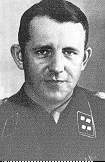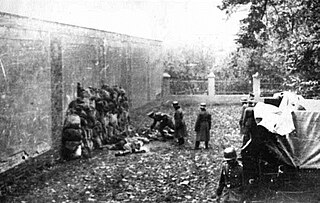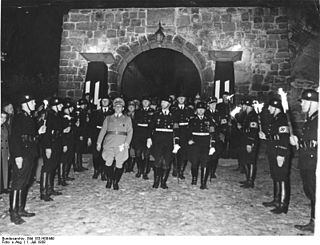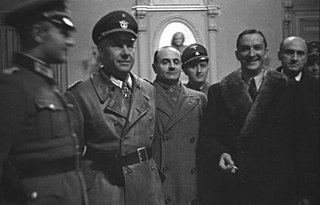
Ernst Kaltenbrunner was a high-ranking Austrian SS official during the Nazi era and a major perpetrator of the Holocaust. After the assassination of Reinhard Heydrich in 1942, and a brief period under Heinrich Himmler, Kaltenbrunner was the third Chief of the Reich Security Main Office (RSHA), which included the offices of Gestapo, Kripo and SD, from January 1943 until the end of World War II in Europe.

The Geheime Staatspolizei, abbreviated Gestapo, was the official secret police of Nazi Germany and in German-occupied Europe.

Reinhard Tristan Eugen Heydrich was a high-ranking German SS and police official during the Nazi era and a principal architect of the Holocaust.

The Lidice massacre was the complete destruction of the village of Lidice in the Protectorate of Bohemia and Moravia, which is now a part of the Czech Republic, in June 1942 on orders from Nazi leader Adolf Hitler and acting Reichsprotektor Kurt Daluege, successor to Reinhard Heydrich. It has gained historical attention as one of the most documented instances of German war crimes during the Second World War, particularly given the deliberate killing of children.

Rudolf Lange was a German SS functionary and police official during the Nazi era. With the invasion of the Soviet Union, he served in Einsatzgruppe A before becoming a commander in the Sicherheitsdienst (SD) and all RSHA personnel in Riga, Latvia. He participated in the January 1942 Wannsee Conference, at which the genocidal Final Solution to the Jewish Question was planned, and was largely responsible for implementing the murder of Latvia's Jewish population during the Holocaust.

Einsatzgruppen were Schutzstaffel (SS) paramilitary death squads of Nazi Germany that were responsible for mass murder, primarily by shooting, during World War II (1939–1945) in German-occupied Europe. The Einsatzgruppen had an integral role in the implementation of the so-called "Final Solution to the Jewish question" in territories conquered by Nazi Germany, and were involved in the murder of much of the intelligentsia and cultural elite of Poland, including members of the Catholic priesthood. Almost all of the people they murdered were civilians, beginning with the intelligentsia and swiftly progressing to Soviet political commissars, Jews, and Romani people, as well as actual or alleged partisans throughout Eastern Europe.

Bruno Streckenbach was a German SS functionary during the Nazi era. He was the head of Administration and Personnel Department of the Reich Security Main Office (RSHA). Streckenbach was responsible for many thousands of murders committed by Nazi mobile killing squads known as Einsatzgruppen.

During World War II, the Nazi German Einsatzkommandos were a sub-group of the Einsatzgruppen – up to 3,000 men total – usually composed of 500–1,000 functionaries of the SS and Gestapo, whose mission was to exterminate Jews, Polish intellectuals, Romani, and communists in the captured territories often far behind the advancing German front. Einsatzkommandos, along with Sonderkommandos, were responsible for the systematic murder of Jews during the aftermath of Operation Barbarossa, the invasion of the Soviet Union. After the war, several commanders were tried in the Einsatzgruppen trial, convicted, and executed.

The Allgemeine SS was a major branch of the Schutzstaffel (SS) paramilitary forces of Nazi Germany; it was managed by the SS Main Office (SS-Hauptamt). The Allgemeine SS was officially established in the autumn of 1934 to distinguish its members from the SS-Verfügungstruppe, which later became the Waffen-SS, and the SS-Totenkopfverbände, which were in charge of the Nazi concentration camps and extermination camps. SS formations committed many war crimes against civilians and allied servicemen.

Kurt Max Franz Daluege was a German SS and police official who served as chief of Ordnungspolizei of Nazi Germany from 1936 to 1943, as well as the Deputy/Acting Protector of Bohemia and Moravia from 1942 to 1943.

The Sicherheitspolizei, often abbreviated as SiPo, was a term used in Germany for security police. In the Nazi era, it referred to the state political and criminal investigation security agencies. It was made up by the combined forces of the Gestapo and the Kriminalpolizei between 1936 and 1939. As a formal agency, the SiPo was incorporated into the Reich Security Main Office (RSHA) in 1939, but the term continued to be used informally until the end of World War II in Europe.

Franz Walter Stahlecker was commander of the SS security forces (Sicherheitspolizei and the Sicherheitsdienst for the Reichskommissariat Ostland in 1941–42. Stahlecker commanded Einsatzgruppe A, the most murderous of the four Einsatzgruppen active in German-occupied Eastern Europe. He was fatally wounded in action by Soviet partisans and was replaced by Heinz Jost.

Karl Hermann Frank was a Sudeten German Nazi official in the Protectorate of Bohemia and Moravia prior to and during World War II. Attaining the rank of Obergruppenführer, he was in command of the Nazi police apparatus in the protectorate, including the Gestapo, the SD, and the Kripo. After the war, he was tried, convicted and executed by hanging for his role in organizing the massacres of the people of the Czech villages of Lidice and Ležáky.

Ležáky, in the Miřetice municipality, was a village in Czechoslovakia. During the German occupation of Czechoslovakia, it was razed by Nazi forces as reprisal for Reich Protector Reinhard Heydrich's assassination in late spring 1942.

Josef Albert Meisinger, also known as the "Butcher of Warsaw", was an SS functionary in Nazi Germany. He held a position in the Gestapo and was a member of the Nazi Party. During the early phases of World War II Meisinger served as commander of Einsatzgruppe IV in Poland. From 1941 to 1945 he worked as liaison for the Gestapo at the German embassy in Tokyo. He was arrested in Japan in 1945, convicted of war crimes and was executed in Warsaw, Poland.
Hans Günther was an SS-Sturmbannführer who was the head of the "Central Office for Jewish Emigration in Prague" during World War II. He was in charge of the deportation of Czech Jews to death camps during the Holocaust. He was killed by Czech partisans in 1945.

Franz Josef Huber was an SS functionary who was a police and security service official in both the Weimar Republic and Nazi Germany. Huber joined the Nazi Party in 1937 and worked closely with Gestapo chief Heinrich Müller. After the German annexation of Austria in 1938, Huber was posted to Vienna, where he was appointed chief of the Security Police (SiPo) and Gestapo for Vienna, the "Lower Danube" and "Upper Danube" regions. He was responsible for mass deportations of Jews from the area. After the war ended, Huber never served any prison time. He was employed by the West German Federal Intelligence Service from 1955–64. He died in Munich in 1975.

Ludwig Hermann Karl Hahn was a German SS-Standartenführer, Nazi official and convicted war criminal. He held numerous positions with the German police and security services over the course of his career with the Schutzstaffel (SS).
Kriminalpolizei, often abbreviated as Kripo, is the German name for a criminal investigation department. This article deals with the agency during the Nazi era.


















